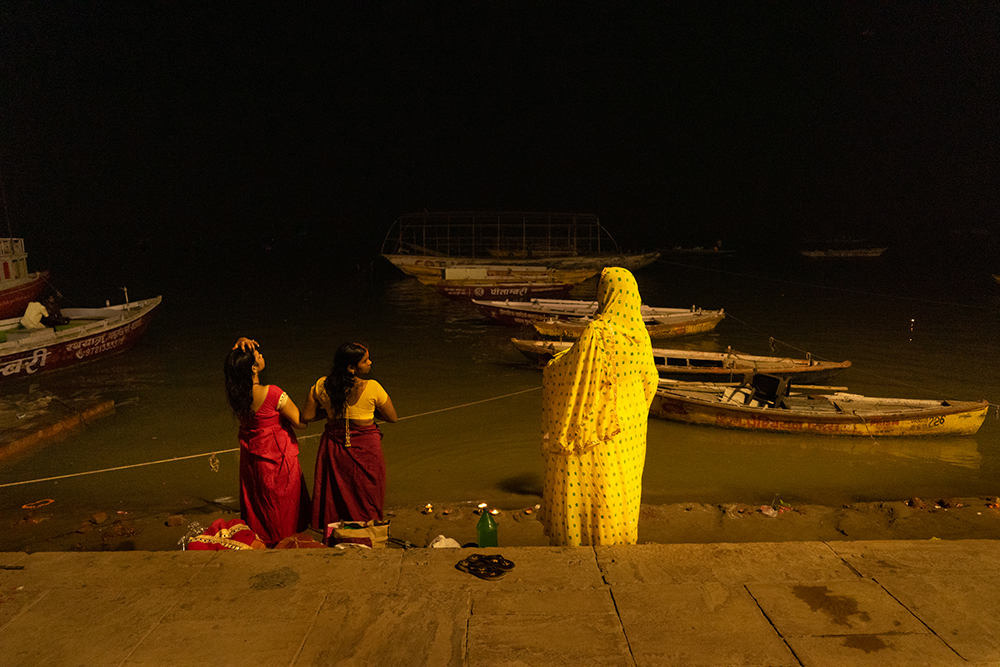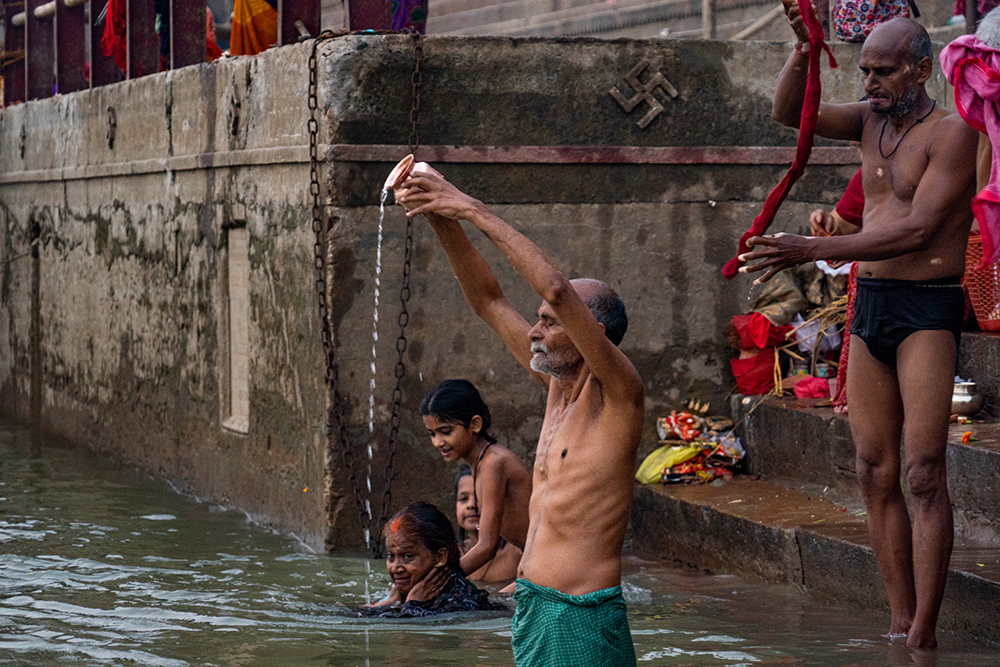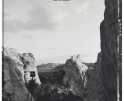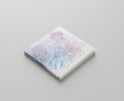David Scheinbaum: Varanasi: City Immersed in Prayer
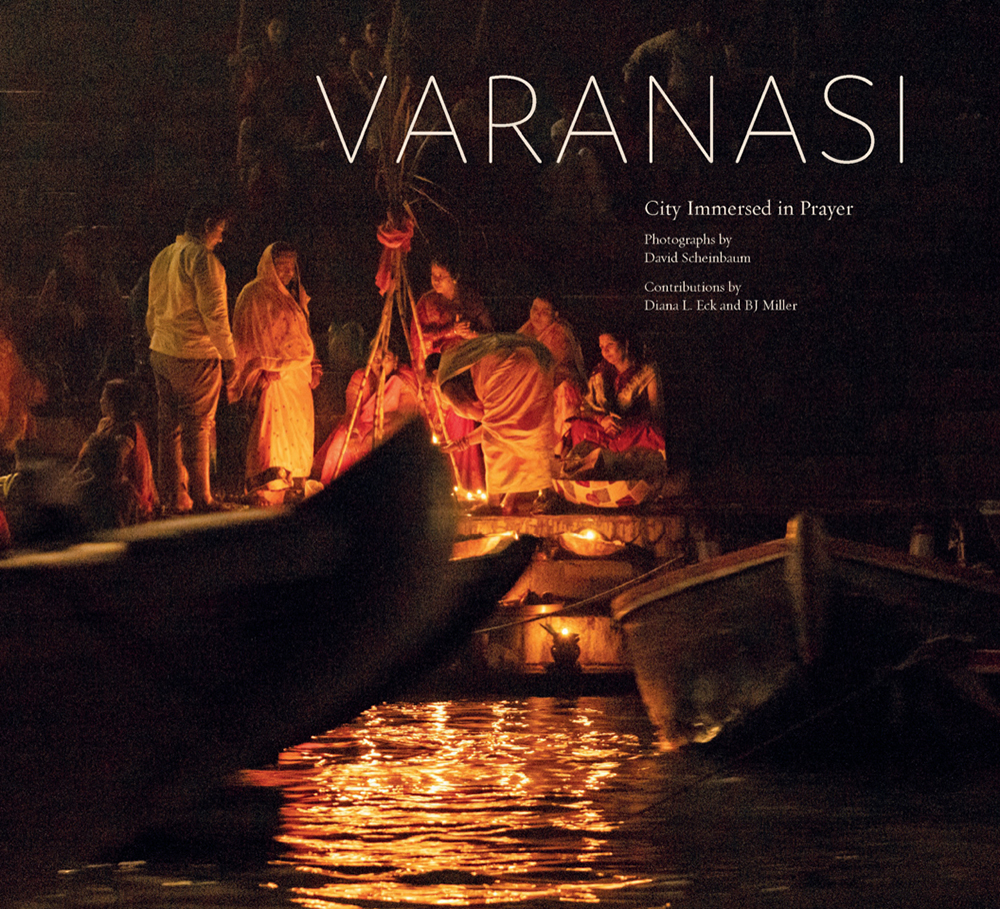
©David Scheinbaum, Book Cover for Varanasi: City Immersed in Prayer, Published by George Thompson Publishing
“David Scheinbaum’s photographs evoke the very spirit of yoga. They remind us of the gifts that remain in nature, and through these powerful images helps reconnect us with nature as well as the spirit within” T.K.V. Desikachar, from a letter, February 3, 2005.
For those of you who have been to India or have a longing to visit, David Scheinbaum’s in-depth photo exploration of one of its holiest cities, Varanasi, provides a visual feast of its unique marvels and traditions. The book titled Varanasi: City Immersed in Prayer pays obvious homage to the primary source of Varanasi’s mystique, the mighty Ganges River that flows by the stone steps or ghats that symbolize this sacred city of the Hindu religion. Worshipers throng these steps at dawn to bathe in the holy river in an ancient ritual that is one of many to behold along the water’s edge. Scheinbaum’s efforts provide the viewer with a startling array of images that bombard the eyes, much as the sights, sounds and smells of the city bombard the senses. One is constantly stunned by the vivid colors and exotic rituals dealing with sobering issues of life and death that make this city such a source of wonder.
Varanasi Is also unique for a specific religious belief of the Hindu faith: if one is cremated along the banks of the river in Varanasi and one’s ashes are released into the holy and purifying water of the Ganges, one’s reincarnation cycle will end and Nirvana is attained. This powerful motivation provokes an unusual scene of active cremations along the banks of the Ganges at all times of day and night. Scheinbaum captures these rituals in vivid images that convey the entire scenario including families carrying the remains of loved ones wrapped in brilliant marigolds to the funeral pyres by the river and the burning pyres both during the day and through the night. It is an eerie scene that is thoroughly documented. He also travels the back streets of the ancient city detailing narrow passageways and unusual scenes of sadhus (holy men) in prayer in colorful attire as well as many visually brilliant bathing rituals that defy description.
The Western eye might find some of the scenes depicted in this homage to a holy city disturbing but Scheinbaum points out that these customs have endured for many centuries with few interruptions. His rationale for photographing Varanasi is compelling in its honesty:
“In the past, my photography has brought me to many places on our planet. I have photographed historic and iconic sites and have been awed by these places and people. I have felt the energy these “power spots” emanate: the Acropolis in Athens, Greece, The Great Wall in China, the giant Moai of the Rapa Nui on Easter Island, the peaceful Zen Gardens of Kyoto, Celtic stones and sites in Scotland, and the Ancient Temples of Angkor Wat in Cambodia, to name a few. In these places and others like them, we can see the historical remnants of past histories. We can learn the stories and, in many cases, we can feel the power and energy in those structures or on those spots. But, in Varanasi, unlike any place I have been, you are in some sort of time warp where you are living in the history as if time there has never stopped, a continuum of thousands of years without much change. The people, both residents and pilgrims, continue their daily practices and worship in much the same way they have been followed for millennia.
Being in Varanasi is like being on a thread that has been pulled from the cloth from the beginning of time. In this city, you don’t see history; you are a part of it. The power of this place to my mind is unparalleled, and although I made photographs here, I don’t pretend, nor am I under any delusions, that it can be captured in pictures alone. It must be experienced to fully understand the secrets she harbors. That said, I have tried to share with you what I experience there.”
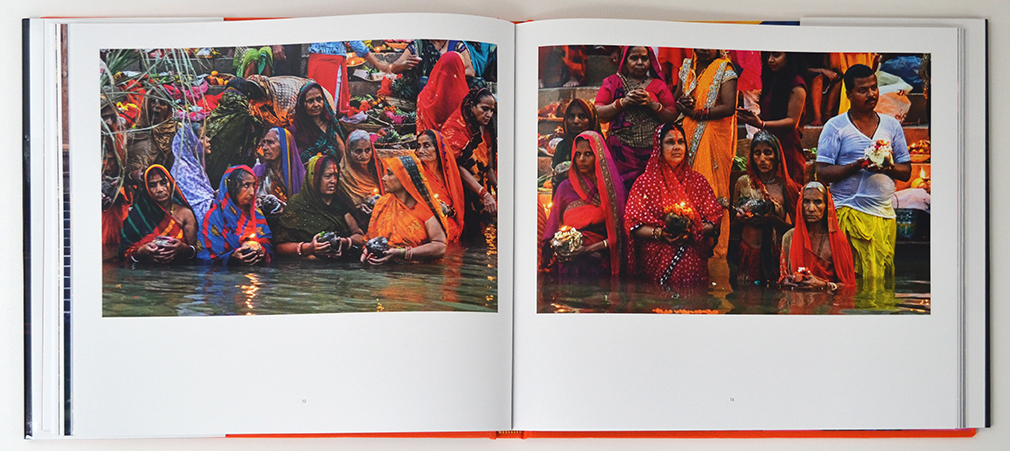
©David Scheinbaum, Spread for Varanasi: City Immersed in Prayer, Published by George Thompson Publishing
David Scheinbaum is the former Director/Chair of the Photography Department in the Marion Center for Photographic Arts at the Santa Fe University of Art and Design and Professor Emeritus at the College of Santa Fe. He is the author of Bisti (University of New Mexico Press, 1987), Miami Beach: Photographs of an American Dream (Florida International University Press, 1990), Stone: A Substantial Witness (Museum of New Mexico Press, 2006), and Hip Hop: Portraits of an Urban Hymn (Damiani Editore, 2012). He and his wife, Janet Russek, have collaborated on three other projects: Ghost Ranch: Land of Light, Photographs by David Scheinbaum and Janet Russek (Balcony Press, 1997), Images in the Heavens, Patterns on the Earth: The I Ching (Museum of New Mexico Press, 2005), and Remnants: Photographs of the Lower East Side (Radius Books, 2017). Together they operate Scheinbaum & Russek Ltd., fine-art photography dealers and consultants in Santa Fe, New Mexico.
The book can be ordered at George Thompson Books.
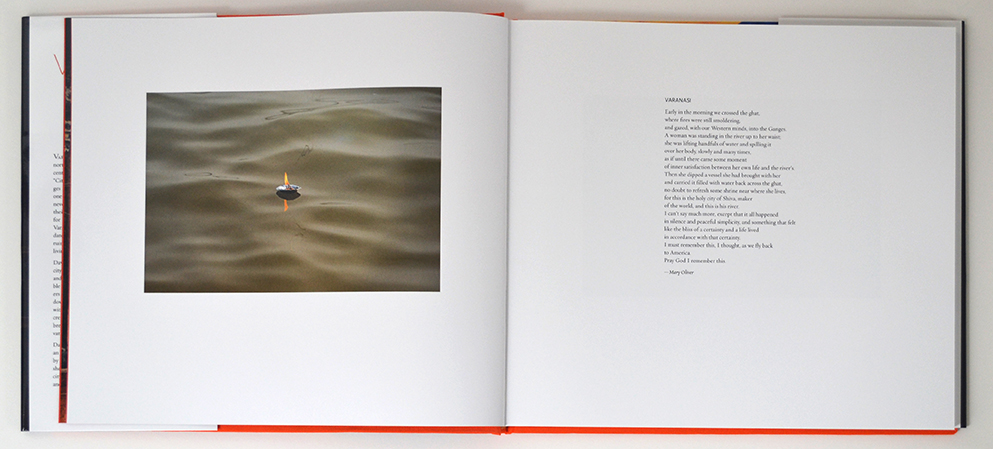
©David Scheinbaum, Spread of Varanasi: City Immersed in Prayer, Published by George Thompson Publishing
From the author:
People ask; I ask myself, what is my interest in Varanasi? How did it come about? Well, I’m not totally sure. I have been practicing various forms of yoga for most of my adult life. In the early 1970s I met and studied under my first teacher, Guru Janardan Paramahamsa. He taught an ancient breathing technique called Ajapa Yoga. Soon after, I began practicing Hatha Yoga at the New York Ashram of Swami Satchidananda and continued that practice for many years under a variety of instructors. About twenty years ago, I began studying Vedic Chant with Sonya Nelson of Santa Fe, whose mentor/teacher was T.K.V. Desikachar, whom I am honored to have known. These experiences still flow through my body and have accompanied me through life. It’s no surprise that these studies led to my interest in India and Hinduism. In the year 2000, I photographed in Southern India while working on my volume Stone: A Substantial Witness and experienced this amazing country first hand.
However, I do not believe that these experiences alone led me to Varanasi.
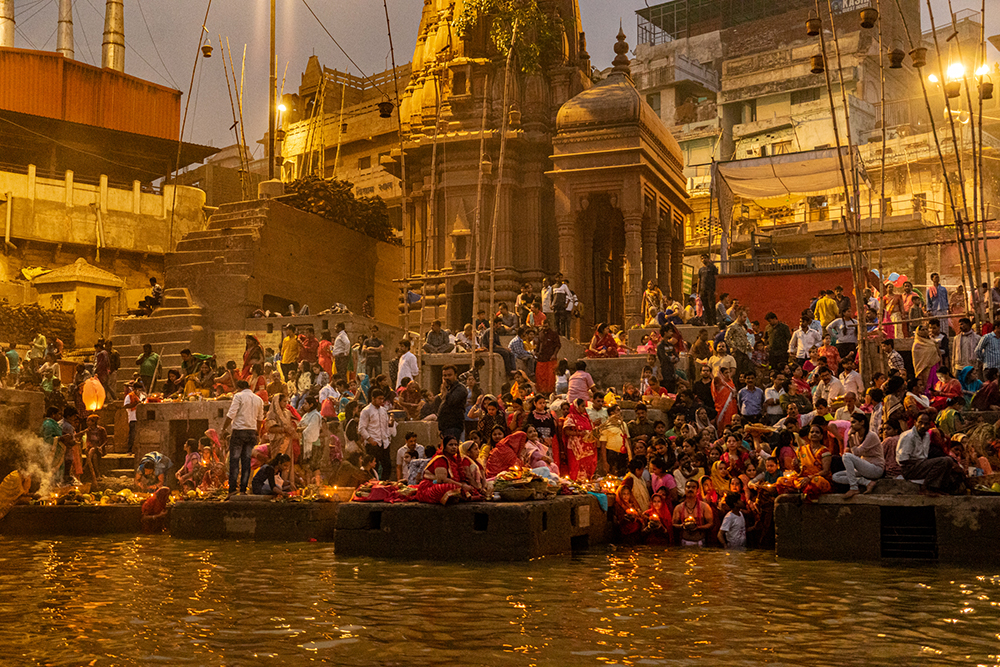
©David Scheinbaum, ThChhat Puja near Manikarnika. from Varanasi: City Immersed in Prayer, Published by George Thompson Publishing
Photography has been my primary form of communication since my teens. In 1978 I relocated to Santa Fe, New Mexico, with the hope of working with my mentor, Beaumont Newhall. In 1980, with my wife/partner Janet Russek, we opened our photography gallery in our home. Soon after, a photographer, Rahoul Contractor, visited us. He was quiet and respectful and had a few photographic prints with him. He was looking to find a location to set up a darkroom to print some of his negatives from India. To this day, etched in my memory, I remember looking at Raul’s few images of slightly blurred figures in the waters of an ancient looking place. So profound was the palate he used, so soft and pastel-like, blends of color in a mysterious haze, figures in the waters backed by ancient buildings. I had not seen photographs like these before. Were they historical? They looked as if they were photographs from the 19th century, but they were in color. He told us about this place, Varanasi. Those images have stayed in my psyche for the past forty years, and it has taken me until 2016 to make my first pilgrimage to Varanasi to experience it for myself. It was not photographing that brought me there at first but the desire to experience the place and people. I wanted to learn about the ancient practices that took place in and around the Ganges. But I did photograph, and those photographs led me to other visits and more image making.
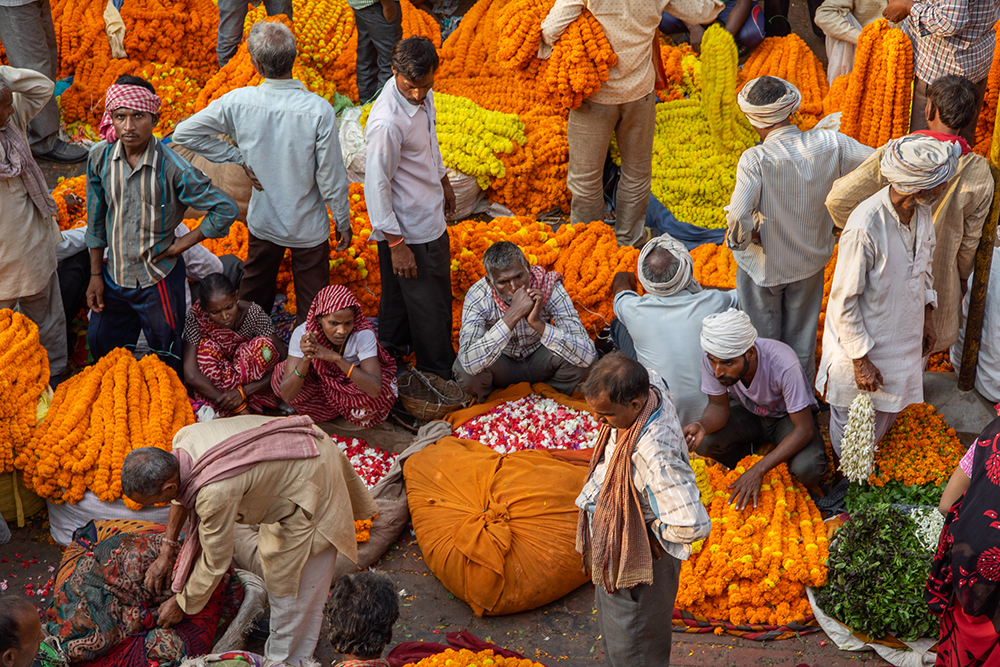
©David Scheinbaum, Marigold garlands for sale at the Chowk Flower Market, from Varanasi: City Immersed in Prayer, Published by George Thompson Publishing
What is hard to capture in still photographs is the fullness of all our senses. One of the first things a visitor experiences is a sensual overload. It is the most cacophonous place I have been; it is so loud, the noise coming mostly from cars, tuk tuks, rickshaws, and bicycles. Everyone keeps a hand on their horn or bell pretty much at all times. The smells, at every inhalation, one experiences mixtures of glorious floral scents, incense, mixed with food smells cooking on the streets and in stalls throughout the city, mixed with urine and feces, both human and animal, and smoke from the burning Ghats. Your eyes, ears, and nose get a workout like never before. The result is both confusion and excitement. At every turn you are seeing and feeling things that can be experienced in few if any other places in the world. But, overriding all this, is a calm and spiritualty that permeates oneself that is so comforting, and regardless if you are seeing a most beautiful flower or someone in deep prayer or a body burning, one feels such a sense of peace that I have no words for.
As I walk the streets and alleys, some so narrow that outstretched arms can touch both sides, you are as likely to be confronted by groups of pilgrims, a motorcyclist, a cow or a body being carried on a bamboo stretcher by family members. Sometimes one can squeeze by; other times you back out or stand in a doorway. The streets are winding, filled with shrines and temples at virtually every step of the way towards the Ghats, the steps leading down to the rivers edge. It’s on the Ghats that one experiences the prayers and ceremony practiced in both life and death. Priests line the water’s edge, offering spiritual guidance and blessing. Sellers of an assortment of goods – candles to float on the river, copper pots to hold her water, beads, flowers – my list would be endless. There is a constant stream of pilgrims walking the shore from beginning to end, stopping for puja at the temples, statuary, or lingams along the way. So much is going on, all day and night. Boatman row (or motor) the river back and forth, especially at sunrise and sunset, to observe the morning and evening ceremonies that both wake and put to sleep the Mother Ganga.
How do my photography projects start? Why do I choose certain subjects? I’m still not totally sure. But I do know for me, I could not devote the time nor immerse myself in a topic that doesn’t begin in my heart. The photographer Ralph Steiner told me that a photographer’s cable release begins in the heart and ends on the shutter button, and the photographer Sebastião Salgado informed me that photographs are given, not taken, and that gift must be earned.
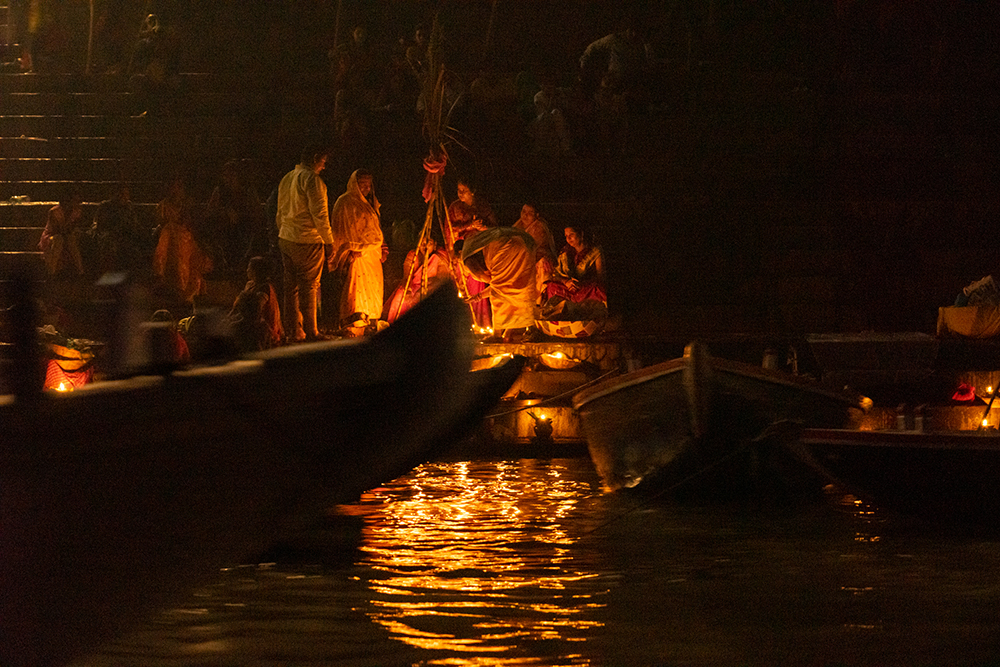
©David Scheinbaum, A family of devotees wait for sunrise at the riverside, from Varanasi: City Immersed in Prayer, Published by George Thompson Publishing
David Scheinbaum is former Director/Chair of the Photography Department in the Marion Center for Photographic Arts at the Santa Fe University of Art and Design and Professor Emeritus at the College of Santa Fe. He is the author of Bisti(University of New Mexico Press, 1987), Miami Beach: Photographs of an American Dream (Florida International University Press, 1990), Stone: A Substantial Witness(Museum of New Mexico Press, 2006), and Hip Hop: Portraits of an Urban Hymn(Damiani Editore, 2012). He and his wife, Janet Russek, have collaborated on three other projects: Ghost Ranch: Land of Light, Photographs by David Scheinbaum and Janet Russek (Balcony Press, 1997), Images in the Heavens, Patterns on the Earth: The I Ching (Museum of New Mexico Press, 2005), and Remnants: Photographs of the Lower East Side (Radius Books, 2017). Together they operate Scheinbaum & Russek Ltd., fine-art photography dealers and consultants in Santa Fe, New Mexico.
About the Contributors:
BJ Miller is an American physician, author, educator, and practicing hospice and palliative medicine physician who is well known for his 2015 TED Talk, “What Really Matters at the End of Life?” He has taught at the University of California, San Francisco School of Medicine, since 2007. In film, BJ is the subject of Netflix’s Academy Award-nominated short documentary, End Game, by veteran directors Rob Epstein and Jeffrey Friedman. His book for approaching the end of life, A Beginner’s Guide to the End, was co-authored with Shoshana Berger (Simon and Schuster, 2019).
Diana L. Eck is Professor of Comparative Religion and Indian Studies and Frederic Wertham Professor of Law and Psychiatry in Society at Harvard University. She is the author of Banaras: City of Light (Alfred A. Knopf, 1982), Darsan: Seeing the Divine Image in India (Anima Books, 1981), and India: A Sacred Geography(Harmony Books, 2012). As the founder and director of the Pluralism Project, she produced the Web-based resource On Common Ground: World Religions in America. On the subject of pluralism, she has written Encountering God: A Spiritual Journey from Bozeman to Banaras (Beacon Press, 1993) and A New Religious America: How a “Christian” Country Has Become the World’s Most Religiously Diverse Nation (Harper San Francisco, 2001). In 1998, she received the National Humanities Medal from President Bill Clinton for her work on religious pluralism in America.
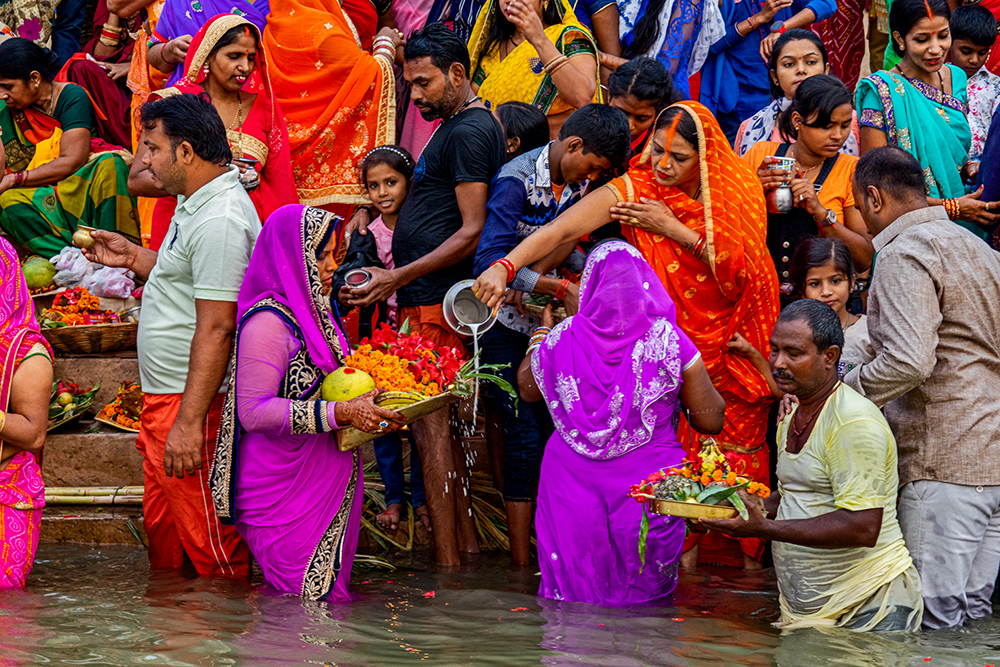
©David Scheinbaum, Offerings to the Sun for Chhat Puja. from Varanasi: City Immersed in Prayer, Published by George Thompson Publishing
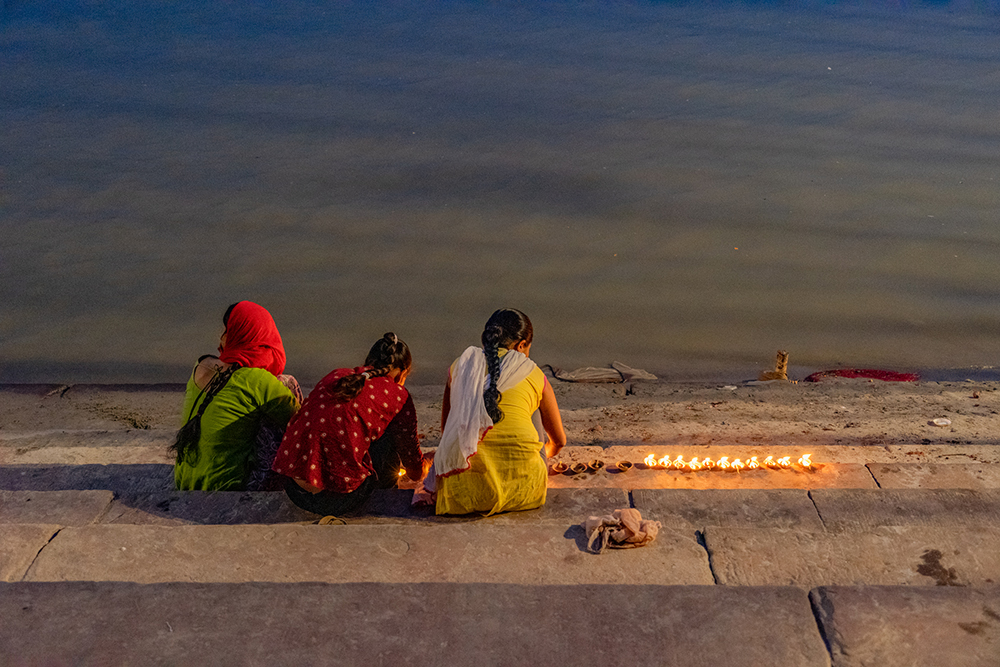
©David Scheinbaum, Tripura Bhairavi Ghat. A family prepares their offerings before sunrise.. from Varanasi: City Immersed in Prayer, Published by George Thompson Publishing
Posts on Lenscratch may not be reproduced without the permission of the Lenscratch staff and the photographer.
Recommended
-
Luther Price: New Utopia and Light Fracture Presented by VSW PressApril 7th, 2024
-
From Here to the Horizon: Photographs in Honor of Barry LopezApril 3rd, 2024
-
Shinichiro Nagasawa: The Bonin IslandersApril 2nd, 2024
-
Kristine Nyborg: Learning to Speak BearApril 1st, 2024

